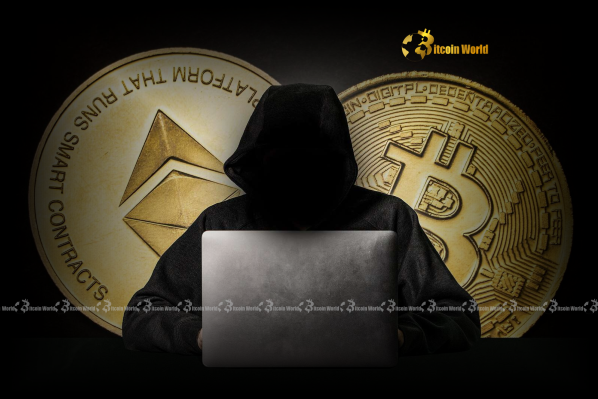BitcoinWorld

Crypto Losses Skyrocket: $2.1 Billion Vanishes in Alarming H1 2025 Exploits
The cryptocurrency world has once again been rocked by a staggering figure: over $2.1 billion in crypto was lost to attacks in the first half of 2025 alone. This alarming revelation, highlighted in a recent TRM Labs report cited by Cointelegraph, paints a stark picture of the ongoing challenges in securing digital assets. For anyone invested in or simply observing the crypto space, this news serves as a potent reminder of the persistent threats lurking within the decentralized frontier. But what exactly led to such immense crypto losses, and what can be done to safeguard against future incidents?
The Alarming Reality of Crypto Losses in H1 2025
The numbers speak for themselves. According to TRM Labs, the sheer volume of funds siphoned off in the first six months of 2025 has nearly matched the entire sum recorded for the full year of 2024. This rapid escalation underscores a worrying trend: while the crypto market continues to evolve, so do the sophistication and frequency of malicious attacks. Out of 75 reported incidents, a significant majority of the stolen funds – over 80% – were linked to specific, high-impact vulnerabilities.
It’s not just the total amount that’s concerning; it’s the nature of the attacks. The report highlights that the most damaging incidents were, on average, ten times more destructive than other types of exploits. This disproportionate impact points to critical weaknesses that attackers are increasingly exploiting with devastating efficiency. Understanding these primary vectors of attack is crucial for anyone looking to navigate the crypto landscape safely.
Decoding the Threats: Private Key Exploits and Front-End Vulnerabilities
So, where are these billions disappearing to? TRM Labs points directly to two primary culprits: private key exploits and front-end infrastructure attacks. These aren’t just technical terms; they represent fundamental weaknesses that, when compromised, grant attackers direct access to funds or control over user interactions.
- Private Key Exploits: Imagine your private key as the ultimate password to your crypto wallet. If this key falls into the wrong hands, whether through phishing, malware, or a compromised system, your funds are as good as gone. These exploits are often direct and leave little room for recovery, as they bypass most security layers designed to protect transactions. They are the digital equivalent of someone stealing the keys to your vault.
- Front-End Infrastructure Attacks: These are more subtle but equally dangerous. The ‘front-end’ is what you see and interact with – the website or application interface. If this infrastructure is compromised, attackers can trick users into approving malicious transactions, redirect funds, or even steal login credentials. This could involve manipulating a legitimate website to display a fake transaction request or redirecting users to a phishing site that looks identical to the real one.
The reason these attack types account for such a large percentage of crypto losses is their direct impact on user funds and the core security mechanisms of digital assets. They bypass smart contract audits in many cases, focusing instead on the weakest link: the human element or the interface layer.
Bolstering Blockchain Security: A Collective Responsibility
Given the escalating threat, what steps can be taken to enhance blockchain security? It’s a multi-faceted challenge that requires vigilance from both projects and individual users. The good news is that awareness and proactive measures can significantly mitigate risks.
For Projects and Protocols:
- Rigorous Audits: Regular, independent security audits of smart contracts and front-end infrastructure are non-negotiable. These audits should be conducted by reputable firms and ideally involve multiple rounds.
- Bug Bounty Programs: Incentivizing white-hat hackers to find and report vulnerabilities before malicious actors do can be incredibly effective.
- Multi-Signature Wallets: For treasury funds or critical operations, implementing multi-signature (multi-sig) wallets adds an extra layer of security, requiring multiple approvals for transactions.
- Decentralized Infrastructure: Reducing reliance on centralized front-ends can decrease the attack surface for infrastructure exploits.
- Incident Response Plans: Having a clear, well-rehearsed plan for responding to security breaches can minimize damage and facilitate quicker recovery.
For Individual Users:
- Hardware Wallets: For significant holdings, hardware wallets (like Ledger or Trezor) are essential. They keep your private keys offline, making them immune to most software-based attacks.
- Strong, Unique Passwords & 2FA: Use strong, unique passwords for all crypto-related accounts and enable two-factor authentication (2FA) wherever possible.
- Verify URLs: Always double-check the URL of any crypto website you visit. Phishing sites often use very similar domain names. Bookmark legitimate sites.
- Be Wary of Phishing: Never click on suspicious links in emails, social media, or direct messages. Always assume a message is a scam until proven otherwise.
- Understand What You Sign: When interacting with dApps, carefully review the transaction details before signing. Ensure you understand what permissions you are granting.
The Impact of DeFi Hacks on Digital Asset Safety
While the TRM Labs report highlights private key and front-end exploits, it’s impossible to discuss large-scale crypto losses without acknowledging the significant role of DeFi hacks. Decentralized Finance (DeFi) protocols, while innovative, often present a larger attack surface due to their composability and complex smart contract interactions. Many front-end vulnerabilities are indeed tied to DeFi applications, where users interact with protocols through web interfaces.
The interconnectedness of the DeFi ecosystem means that a hack on one protocol can sometimes have ripple effects, impacting others. Flash loan attacks, re-entrancy bugs, and oracle manipulations are common in the DeFi space, alongside the front-end and private key issues that affect the broader crypto landscape. The rapid evolution of DeFi also means new vulnerabilities are constantly emerging, demanding continuous innovation in security measures to maintain digital asset safety.
Navigating the Future of Digital Asset Safety
The first half of 2025 serves as a harsh but necessary wake-up call. The escalating figures for crypto losses underscore the urgent need for a more robust and proactive approach to security across the entire digital asset ecosystem. It’s a continuous arms race between innovators and attackers, and vigilance is paramount.
The industry must invest more heavily in security research, implement standardized best practices, and foster greater collaboration among projects, security firms, and law enforcement. For users, the message is clear: personal responsibility in securing your assets is more critical than ever. As the digital economy expands, so too does the value of what’s at stake.
Ultimately, while the figures are daunting, they also spur innovation. Every major hack pushes the industry to develop better defenses, more secure protocols, and more resilient infrastructure. The journey towards truly secure and universally trusted digital assets is ongoing, and learning from these painful lessons is a vital step forward.
To learn more about the latest crypto market trends and enhance your digital asset safety, explore our articles on key developments shaping the future of decentralized finance and blockchain security.
This post Crypto Losses Skyrocket: $2.1 Billion Vanishes in Alarming H1 2025 Exploits first appeared on BitcoinWorld and is written by Editorial Team





